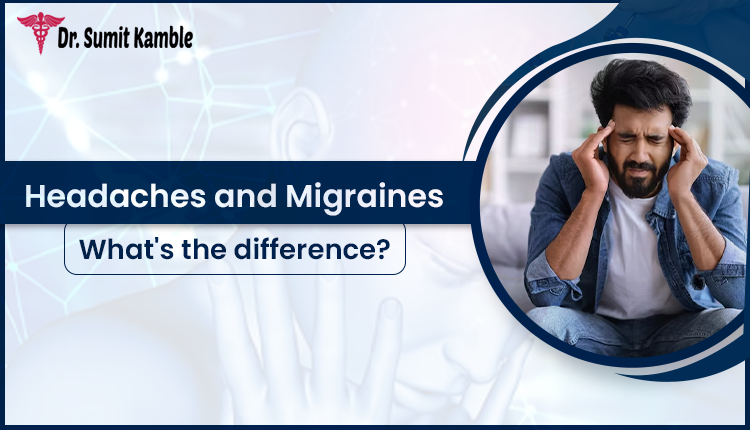What is The Difference Between A Headache and A Migraine?

According to the World Health Organization, around 50% of the global population experiences headaches annually. Migraines affect approximately 1 billion people globally, with women being three times more susceptible.
Understanding the difference between a headache and a migraine is crucial for effective pain management. While both share common ground, distinct characteristics set them apart. In this blog, we will learn the difference between headache & migraine. Explore this blog to understand the distinctions between the two and access appropriate treatment for migraines and headaches
Understanding The Headaches
Feeling pain or discomfort in your head or neck is often a sign of a headache. Many people experience this, and it can happen for various reasons like stress, not drinking enough water, or sinus issues. One common type is a tension headache, occurring when the muscles in your head and neck tighten due to stress, resulting in a constant and lingering ache.
In addition to stress, other triggers for headaches include lack of sleep, bright lights, or certain foods. Paying attention to these factors can help identify what might be causing your headaches. If you find yourself facing a continuous, dull pain, it’s likely a headache induced by stress or other factors.
In the difference between a headache and a migraine, manage headaches better by considering simple remedies like staying hydrated, managing stress through relaxation techniques, and ensuring you get enough rest. If the pain persists, consulting a healthcare professional like Dr Sumit Kamble who is the best neurologist in Jaipur can provide tailored advice and strategies for effective relief. Understanding the various causes and potential solutions empowers you to navigate and alleviate the discomfort associated with headaches
Exploring Migraine
Experiencing severe and throbbing pain in your head often indicates a migraine. In the differences between a headache and a migraine, migraines can be intense and may bring along additional symptoms such as nausea, sensitivity to light, and visual disturbances. Many people endure migraines, and they can be triggered by factors like hormonal changes, certain foods, or stress.
Apart from these triggers, lack of regular meals, irregular sleep patterns, and excessive noise can also contribute to migraine episodes. Identifying specific triggers can assist in managing and preventing migraines more effectively. If you notice recurring episodes of pulsating pain along with symptoms like nausea or sensitivity to light, it’s likely a migraine.
Taking steps to manage migraines involves staying hydrated, maintaining regular meals, and incorporating relaxation techniques into your routine. However, for personalized advice and targeted relief, consulting a healthcare professional is essential. Understanding the distinctive features of migraines empowers you to adopt proactive measures for better management and a higher quality of life.
The Difference Between A Headache and A Migraine
When your head hurts, it’s natural to think it’s just a headache. But did you know there’s a big difference between a regular headache and a migraine? Let’s break it down in simple terms.
Headaches are pretty common. They can make your head or neck ache and might happen because of stress or some other issues, but migraines are a bit more complicated. They go beyond a regular headache. Migraines come with severe throbbing pain and often bring friends like nausea, sensitivity to light, and weird visual stuff.
Let’s get to know the exact difference between a headache and a migraine with the following table
| Basis of Difference | Headache | Migraine |
| Pain Location | Any part of the head | One-sided, pulsating |
| Intensity | Mild to moderate | Moderate to severe |
| Duration | Typically a few hours | Can last for days |
| Nature of Pain | Dull, steady ache | Throbbing, pulsating |
| Associated Symptoms | Rare | Common (nausea, aura) |
| Impact on Daily Life | Mild | Significant disruption |
| Triggers | Stress, dehydration | Hormonal changes, specific foods |
| Response to Medication | Usually effective | Varied, may require specific treatments |
If you are confused about headaches or want to know more about then read this blog- the difference between primary and secondary headaches
How do you know if you have migraine or a type of headache?
Understanding whether you’re experiencing a migraine or a headache is crucial for targeted relief. Get to know, if you are having a migraine or a headache with the following points-
· If you are having a persistent, dull ache typically indicates a common headache, while a throbbing, pulsating pain is a a migraine.
· Headaches tend to follow a consistent pattern without specific triggers. In contrast, migraines may be episodic and linked to factors like hormonal changes, certain foods, or environmental influences.
· Headaches are often present as standalone discomfort, while migraines are often accompanied by additional symptoms such as nausea, heightened sensitivity to light, and visual disturbances.
· Headaches typically resolve within a few hours, whereas migraines can persist for an extended period, lasting days in some cases.
· While headaches may allow for routine activities despite the discomfort, migraines significantly impact daily life, often requiring rest and limitations on regular tasks.
Conclusion
Comprehending the difference between a headache and a migraine is integral to accurate diagnosis and targeted relief. Identifying the type of discomfort one is experiencing enables individuals to adopt tailored approaches for effective pain management. So, the next time your head hurts, pay attention. If it’s a steady ache and doesn’t last too long, it’s probably a headache. But if it’s a pulsating pain, that sticks around, it might be a migraine. Knowing the difference helps you figure out how to deal with it better.
For personalized advice and effective ways to get rid of headaches or migraine, you can consult with Dr Sumit Kamble, an expert in treating neurological disorders. Reach out to Dr. Kamble, a neurologist in Jaipur today to take the first step toward a life with less pain.
FAQs:

 Next Post
Next Post